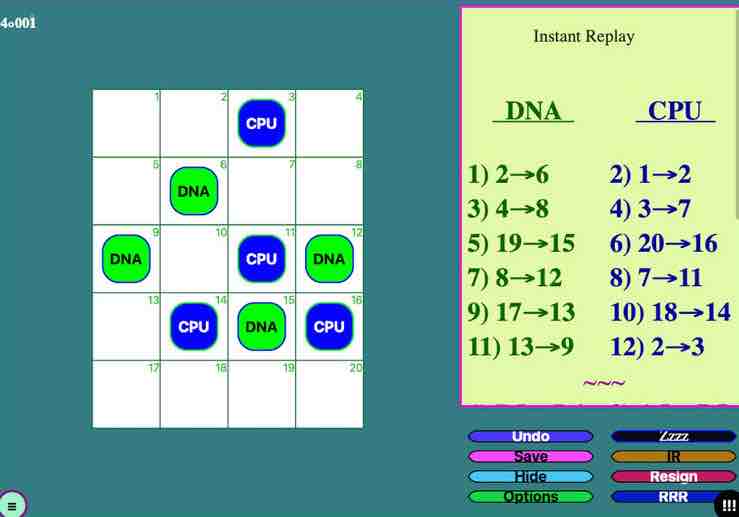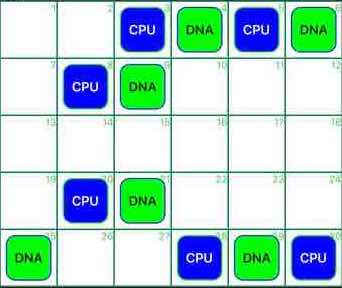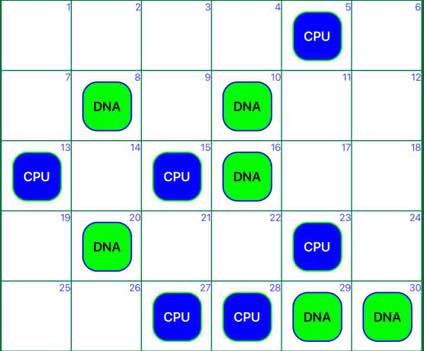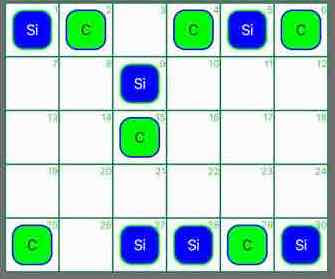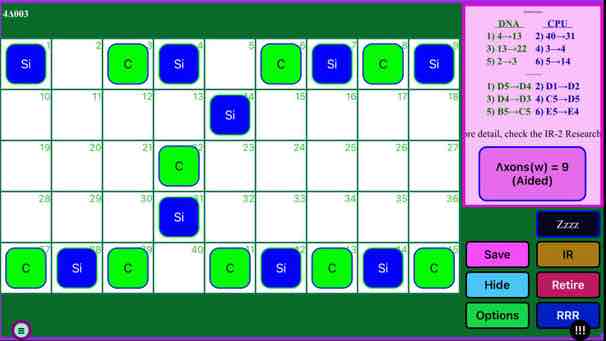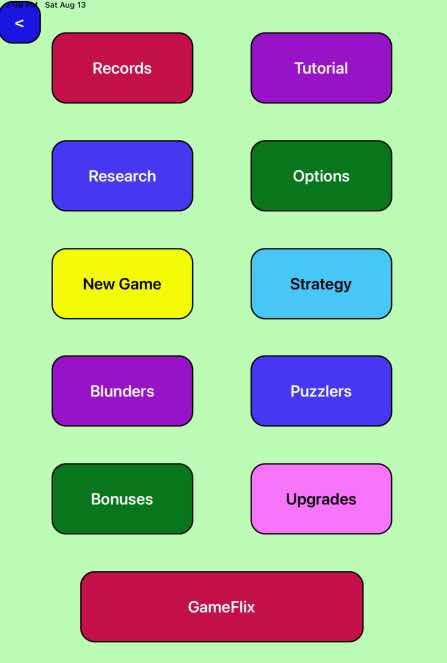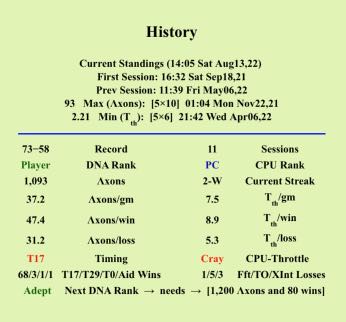DNAvs CPU
 DNAvs CPU (a.k.a. 17)
is an iPhone/iPad game of strategy,
where you pit your skill in planning ahead against my internal and
learn-on-the-fly algorithms. 17 attempts to
employ some simple Artificial Intelligence techniques to improve
play, so my performance may improve over time.
DNAvs CPU (a.k.a. 17)
is an iPhone/iPad game of strategy,
where you pit your skill in planning ahead against my internal and
learn-on-the-fly algorithms. 17 attempts to
employ some simple Artificial Intelligence techniques to improve
play, so my performance may improve over time.
- DNAvs CPU is comprised of four
Generations. Each Generation includes
four Levels (A,C,G,T) with a total of 17 different games
‐ A: Astronomic (7 games),
C: Cosmic (5 games),
G: Galactic (3 games), and T: Tumultuous (2 games).
At each Generation, players start at
Level A: Astronomic.
Each Level and game is progressively harder and worth more.
A win at Game X earns access to Game X+1.
- When you win all 17 games in a Generation, you may
ascend to the next Generation.
Although the 17 games appear similar
in each Generation, rule changes and CPU performance upgrades make
each successive Generation noticeably more challenging.
Winning all 17 games at the highest Generation may reveal
an Easter Egg.
- 17 is played on a rectangular grid.
It's based on the 5×4 game
tac-tickle developed by Harry D. Ruderman in 1967.
17 has added a GUI, machine play
(augmented with some simple machine learning), a variety of
game sizes, undo, some quantum effects, instant replay,
a video archive of your previous games,
and user-viewable stats, summaries, and research reports.
17 is locked into Landscape Mode.
- The objective is to get 3 of your tokens in a row: up/down,
left/right, or diagonally – like tic-tac-toe (see
below for sample board layouts).
- Your tokens are green, mine are blue. Token names may
change (depending on how well you play), but token colors do
not change. You may select one of several avatars as
your personal token.
- We alternate turns, and alternate who moves first
in each game. You move first in the first game.
After 17 moves a draw is declared.
- A player may move one of their tokens one cell up,
down, left or right (but not diagonally) to an open cell.
You must move on each turn.
To move, tap one of your tokens, then tap
the destination cell. For the harder games (Levels C,G,T),
quantum tunneling and wormholes may come into play and more
aggressive moves are available.
- You earn points with a win: faster play is rewarded with
more points. You may lose points with a defeat.
Your cumulative points are displayed. As your points add
up, you may be promoted (there are 21 levels). After your
first win at your current largest (hardest) game size,
a new (harder) game is
introduced from which you may choose. Harder game wins are worth
more points. As harder games are introduced, the points
for easier game wins is reduced. Also, as harder games are
introduced, the time to make a move is reduced.
- Overall goals: Build your points by winning increasingly-difficult
games; Move up the Promotion Ladder (21 levels);
Earn your way to
T⋮10, the hardest, most rewarding game. Be
careful at T⋮10, because some of your learned
game behaviors may not work as you think.
- DNAvs CPU
is easy to play, but hard to play fast.
The scoring system strongly rewards fast play and
mercilessly punishes slow play.
- A variety of actions and reports are available for your use
during play or between games (e.g., Undo, Instant Replay,
Statistics, Opener/Responder Winning Efficiency, ...).
Note however that employing some of them during play (e.g., Undo,
Sleep) drastically reduces the maximum points awarded for a win.
- My "learning" ability is heavily dependent on your style of
play and performance, and it will vary from player-to-player.
An open question is whether your inexperienced play in the early
games causes me to learn bad habits (thus making it easier for
you to win more often in the long term). Learning is a
bumpy road. It is likely you will see me commit some
stupendous blunders as I try to learn.
- Beginners can gain some useful insights from the video replays
of previous games, and from the
[Strategy], [Puzzlers], and [Blunders] reports.
- Experienced players may wish to use Tournament Mode
which provides a mechanism for you to periodically gauge your
skill level,
or more likely to compete against other players (in the same real
or virtual room). Possible goals may be how long til 1,500
Λxons, 100 wins, Level C or G or T, win one of
each of the 17 games, or
average Λxons per game (for 100 games), minimum
think-times per game (for 100 games), ...
- To Prevail (not easy!):
- Work your way up the game ladder (3 Generations with 4 levels
each for a total of 51 games)
to meet and defeat the 4th Generation (Easter Egg Challenge).
- Play some practice tournaments on your own to get
comfortable playing under pressure. Then play in
tournaments with other players to gauge your
mastery.
- Internet access is not required to play (17 is
completely self-contained and does not communicate with the
outside world.)
- No data collection (for use outside the app) is performed.
- To contact us, Email: DNAvsCPU@DNAvsCPU.com
The information on this
web site is a small subset of the internal documentation in
the App. Click the AppStore icon to visit the iTunes store,
or click on an item below to explore further.
~~~//~~~
~~~//~~~
Screenshots
Below is an array of boards (each at mid-game) and some other random
screen shots.
- [Upper Left] DNA (Green) to move and win in 2.
How? What do you think of CPU's last move? What
would you have done?
- [Upper Right] Blue to move and has a sure win in 2. How?
If instead it is Green's turn, Green also has a forced
win in 2. How?
- The next three boards have that same attribute (the player
who is about to move has a forced win). How? Note that
this condition is not always the case, but it does suggest that
the first player to move may have an advantage.
- A peek at some of the reports. [Strategy],
[Blunders], and [Puzzlers] might be interesting to beginners,
or at least worth a chuckle.
- A brief player History
